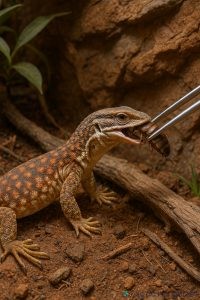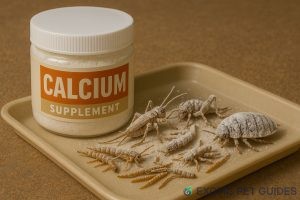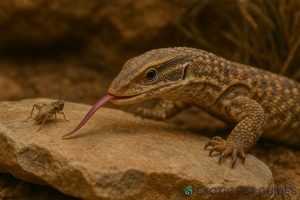Feeding your Ackie Monitor properly is key to ensuring its health, energy, and long-term well-being. These small monitors are active insectivores with fast metabolisms and big appetites — but not all bugs are equal when it comes to nutrition.
In this comprehensive feeding guide, we’ll cover:
- The best feeder insects for Ackies
- How often to feed them
- What supplements are essential
- Safe feeding practices and common mistakes to avoid
🦗 Best Feeder Insects for Ackie Monitors
Ackies require a high-protein diet composed mainly of live insects. Here’s a list of the top feeders:
| Insect | Notes |
|---|---|
| Dubia Roaches | Excellent staple, high protein, low fat |
| Crickets | Good for variety, but lower nutrition than roaches |
| Black Soldier Fly Larvae | Naturally high in calcium |
| Superworms | Great for adults, use in moderation (high fat) |
| Hornworms | Hydrating treat, low in fat |
| Silkworms | Nutritious and soft-bodied |
| Mealworms | Can be used occasionally, higher chitin |
Avoid wild-caught insects and fireflies (toxic) at all costs.
📆 Feeding Schedule
| Age | Frequency | Portion Size |
|---|---|---|
| Hatchling (0–3 months) | Daily | As much as they’ll eat in 10–15 mins |
| Juvenile (3–8 months) | 5–6 times per week | 4–8 insects per feeding |
| Adult (8+ months) | 3–4 times per week | 6–10 insects, depending on size |
Tip: Remove uneaten insects after 15–20 minutes to prevent stress or injury.
💊 Supplements: Calcium & Vitamins
Ackies in captivity need supplementation to mimic wild nutrition.
- Calcium (without D3): Use at every feeding
- Calcium with D3: Use 1x per week if you don’t have high UVB lighting
- Multivitamin: Use once every 1–2 weeks
Dust insects lightly before feeding — over-supplementing can be harmful.
💡 Feeding Tips & Enrichment
- Use tongs or a feeding dish to avoid accidental bites
- Occasionally let them hunt loose insects to stimulate natural behaviors
- Avoid feeding fatty insects like waxworms regularly
- Never feed pinky mice — Ackies are insectivores, not carnivores
⚠️ Common Mistakes to Avoid
- ❌ Feeding only one insect type (causes nutrient imbalance)
- ❌ Skipping calcium (leads to MBD)
- ❌ Using UVB lighting but still overdosing on D3
- ❌ Leaving uneaten insects in the enclosure overnight
✅ Summary Checklist
✔ Dubia roaches and black soldier fly larvae as staples
✔ 3–6 feedings/week depending on age
✔ Daily calcium (w/ or w/o D3 depending on UVB)
✔ Provide feeding enrichment when possible
✔ Monitor body condition monthly



